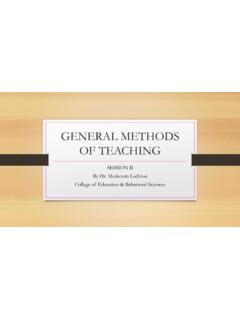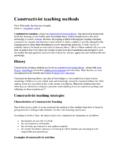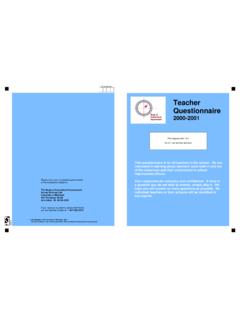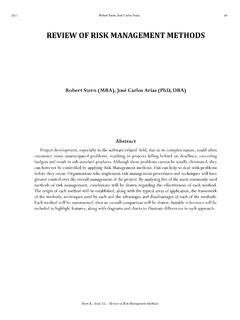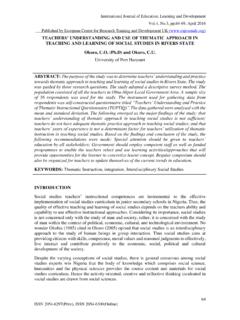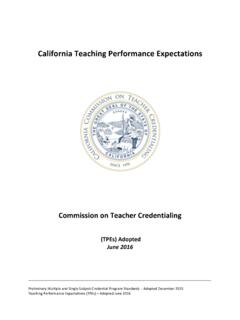Transcription of Principles and Practices of Teaching English Language Learners
1 International Education Studies; Vol. 12, No. 7; 2019. ISSN 1913-9020 E-ISSN 1913-9039. Published by Canadian Center of Science and Education Principles and Practices of Teaching English Language Learners Abha Gupta1. 1. College of Education and Professional Studies, Old Dominion University, Norfolk, Virginia, USA. Correspondence: Abha Gupta, College of Education and Professional Studies, Old Dominion University, Norfolk, Virginia 23529, USA. E-mail: Received: March 12, 2019 Accepted: April 25, 2019 Online Published: June 29, 2019. URL: Abstract This conceptual paper presents diverse approaches and strategies for preparing competent teachers who work with either English Language Learners (ELLs) or students who speak English as a Second Language (ESL).
2 The pedagogical approaches discussed herein include practical and hands-on activities for teachers at any level. Bilingual learning improves ELL's cognitive development as well as their self-esteem. The paper outlines underlying Principles for the best Practices with an emphasis on ESL students and also to other learning situations and students. Teachers can modify their instructional methods to adjust ELL's learning needs. Specifically, even though the discussion is framed in the context of ESL students in classrooms, it is applicable to TEFL. ( Teaching English as a Foreign Language ) environments in schools and other centers of learning.
3 Keywords: English as Second Language (ESL), English Language Learner (ELL), Teaching English to Speakers of Other Languages (TESOL), bilingual Learners , Teaching strategies 1. Introduction Issues in Teaching English as a Second Language The increasingly diverse environment of today's classrooms provides a rich opportunity for teachers and students to engage in effective learning. With a growing number of English Language Learners worldwide, there is a critical need for general education and resource teachers to know how to effectively build and implement literacy programs that are inclusive of students' Language and culture. Understanding that culture goes beyond the knowledge of ethnic attire, music, food, and Language ; it includes the total being, comprised of the totality of the student's background, heritage, ancestry, educational, political, and life.
4 The importance of Teaching ESL students is critical in the current climate with increasing accountability by way of student performance on standardized tests. ESL students are expected to be on grade level proficiency within three years and teachers are held accountable for their learning (Curtin, 2005). There are a variety of terms that have been used for non-native English speakers, ranging from LEP (Limited English Proficient), ESL students ( English as a Second Language ), Bilingual students and English Language Learners (ELL). For practical purposes, we use the term ESL students for a student whose mother tongue is not English . As educators, we understand that ESL students have to double their efforts in school, to not only learn new information but also learn the academic Language of the school.
5 Freeman and Freeman (2011, ) state, ESLs face double the work of native English speakers. They must learn English , and they must learn academic content through English . In addition, they often live in neighborhoods where the schools are underfunded and are staffed by inexperienced teachers. On the same note, teachers of ESL students face double work of Teaching core competencies enlisted in the curriculum to meet the benchmarks and teach English to non-native speakers. It is a double-whammy. While we realize that no two students are alike and that no two students have the same needs, there are commonalities among Learners that help us approach our Teaching in a more informed way.
6 The paper proposes foundational Principles and Practices for teachers who work with ESL students in their classrooms. School Culture and Educational Environment It is important to consider how the culture of the school eases when a new ESL student enters into the classroom to create a sense of belonging. Using a framework of compare and contrast can be instructional and useful in learning about two cultures. There are commonalities and differences in comparing different cultures. Reaching out to parents by using a few phrases in their native Language while greeting them can instantly break down the social barriers between the teachers and the parents.
7 Now with Google Translate, it can be easily done. Creating a 49. International Education Studies Vol. 12, No. 7; 2019. welcoming climate for students new to the country and culture provides the first step in easing into a learning situation. Seating students next to another student who has a similar background can ease the jitters caused by an alien culture and Language . 2. Method This conceptual paper focuses on the description of pedagogical strategies stemming from a theoretical framework that has evolved out of second Language learning research. Research on ESL/ELL strategies is based on the findings that building on Learners ' background by providing comprehensible input and multiple opportunities for interaction is the key to second Language proficiency.
8 These findings lead to the development of a set of strategies built on the framework of Principles of learning the second Language outlined below. Seven Principles of second Language learning have been identified as critical to successfully Teaching ESL. students. 1) Know your student and motivation to learn the second Language 2) Create a welcoming classroom environment 3) Build Background Knowledge 4) Provide Comprehensible Input by building vocabulary 5) Include frequent opportunities for Interaction and Discussion 6) Use Multiple Modalities during instruction 7) Conduct ongoing review and assessment These Principles provide a basis for developing a broader theory for second Language learning.
9 Cummins (1980) discusses the context-embedded Language and its effectiveness with ESL Learners . For instance, repetition of classroom routines provides non- English speakers with meaningful Language learning opportunities because the words and phrases that accompany such routines are constantly repeated within a concrete context. For instance, a word like lavatory' will become a part of their lexicon, if used by a teacher on a routine basis every time for a bathroom break. Using synonyms or rephrasing keywords differently reinforces meaning. Creating a low-stress environment necessary for students to feel ready to participate in a larger group setting provides a less threatening environment for a student to take a risk.
10 Established routines facilitate learning as students know what to expect and begin to thrive in that environment. Know Your Student and Motivation to Learn the Second Language One of the most important things to do is to get to know your student you are sharing your classroom space and time with. Getting to know your student will go a long way in building a strong relationship and bonding with them. This knowledge will greatly help educators respond in an informed way as they work with their English Language Learners . It is one thing to read about English Language Learners and discuss theoretical models in the setting of a university classroom; it is another to work with the students directly and apply what teachers know.










